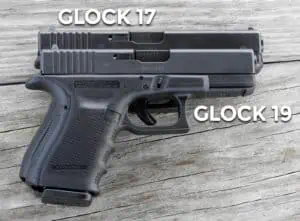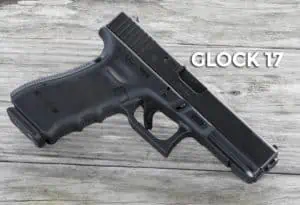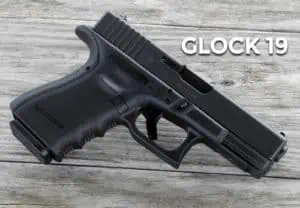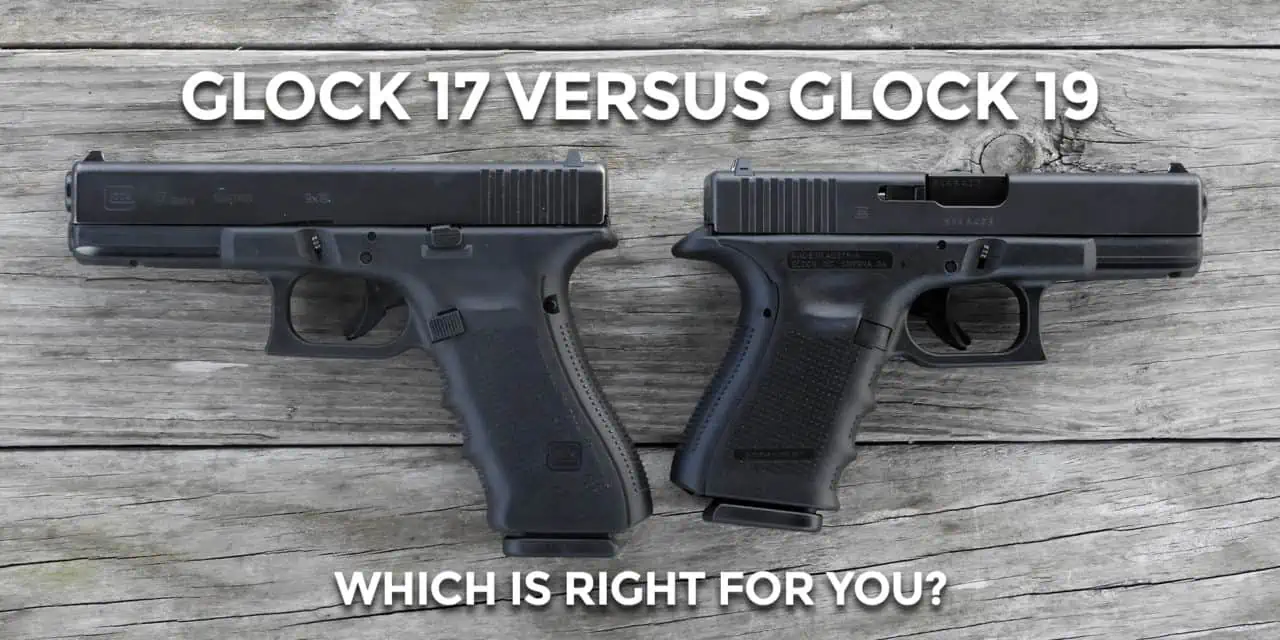Glock 17 Versus Glock 19: Which Works Best For You?
We often hear the word “revolutionary” attached to new products in the firearms world. Yet, the number of guns that actually revolutionize the gun industry is quite low.
When Glock introduced the G17, it truly changed everything we thought we knew about guns. The company quickly followed up with its smaller sibling, the Glock 19. There are some subtle (and not-so subtle) differences between the two guns. In this post, we’ll take a look at them and see how they stack up against one another.
Gaston Glock designed the Glock Model 17 in the early 80’s to be a contender as the Austrian army’s new 9mm service pistol. It wasn’t the first production gun to use a polymer frame (that honor belongs to the H&K VP70), nor was it the first pistol to use a striker-fired action. The Glock 17’s genius was in how it took those elements and combined them into a simple, easy-to-maintain gun that was both lightweight and accurate.
The Model 19 was the third gun Glock produced. (The Model 18 is a version of the Model 17 designed for an Austrian counter-terrorism unit with an option for fully automatic fire). It takes all the Glock 17’s functionality and features and shrinks them down slightly, making for a more compact gun that is easier to carry.
What Are The Differences Between the Glock 17 and Glock 19?
 As we mentioned, Glock originally designed the Model 17l for the Austrian army. As such, it was meant to be worn by soldiers in the field. Its accuracy, ruggedness, and light weight made it an attractive option for people. But many shooters needed a slightly smaller pistol.
As we mentioned, Glock originally designed the Model 17l for the Austrian army. As such, it was meant to be worn by soldiers in the field. Its accuracy, ruggedness, and light weight made it an attractive option for people. But many shooters needed a slightly smaller pistol.
So, Glock quickly rolled out the Model 19 to fill the demand for such a gun.
Over the years, Glock updated the design of their pistols. They added features like textured grips and finger grooves for a better grip, as well as interchangeable back straps for a better fit in your hand. In the latest Gen 5 models, they’ve also changed the internal mechanism slightly. For our comparison, we looked at the Gen 4 Model 17 and Model 19. Both have proven to be consistent, reliable performers for civilians, military, and law enforcement.
Size Comparison: Glock 17 vs Glock 19
 In your hand, there are few differences between the Glock 17 and the Glock 19. The guns feel essentially the same, although the Model 19 has a slightly shorter grip.
In your hand, there are few differences between the Glock 17 and the Glock 19. The guns feel essentially the same, although the Model 19 has a slightly shorter grip.
The two guns are the same width (1.26 inches) and the same distance from the back of the slide to the ejection port. Both the Gen 4 Model 17 and the Model 19 feature interchangeable back straps, although the Model 17’s back straps will not fit the Model 19, and vice versa. The Glock 19 in our photos is my own personal Model 19. It has a back strap with a small extension up near the slide, which is different than what the Model 17 is using.
The height of the two pistols is also different. The Glock 17’s standard magazine holds 17 rounds, while the Glock 19’s standard magazine holds 15 rounds. At 5.47 inches, the Model 17 has a frame that is taller by just under half an inch than the Model 19’s 5.04 inches. The Model 17 weighs 32.3 ounces unloaded. The smaller Model 19 weighs 23.6 ounces.
Barrel and slide length are where we see the biggest difference between the Glock 17 and the Glock 19. The Gen 4 Model 17 has a slide length of 7.32 inches and a barrel length of 4.49 inches. The Glock 19 has a slide length of 6.85 inches and a barrel length of 4.02 inches.
Because of the different barrel and slide lengths, the recoil springs are not interchangeable between the two. However, all the fire control parts in the frame can be swapped between the two guns.
Range Comparison
We tested the Glock 17 and the Glock 19 for accuracy using three commonly available brands of 9mm ammunition:
Both guns were shot from a rest at a target 15 yards away. We tested for average velocity and average group size using a ProChrono Digital chronograph that was set up just beyond the muzzle of each pistol. The temperature was 85 degrees at the time of the test with 85-percent humidity.
The heavier Glock 17’s made it seem more controllable under recoil than the Glock 19. However, both pistols turned in excellent results in our accuracy tests. The Glock 17’s longer barrel allows for more of the powder inside the cartridge to burn while still in the rifling of the barrel. This resulted in slightly higher muzzle velocities for the Glock 17 versus the Glock 19.
Glock 17 Range Test
| American Eagle 115gr FMJ | Average Velocity: 1190.2 fps | Federal 124gr HST | Average Velocity: 1163.4 fps | Sellier & Bellot 115gr FMJ | Average Velocity: 1189.5 fps |
| Velocity (fps) | Velocity (fps) | Velocity (fps) | |||
| 1195 | 1140 | 1204 | |||
| 1190 | 1135 | 1217 | |||
| 1193 | 1177 | 1182 | |||
| 1177 | 1152 | 1184 | |||
| 1196 | 1174 | 1175 | |||
| 1194 | Group Size (In) | 1138 | Group Size (In) | 1173 | Group Size (In) |
| 1202 | 1.11 | 1178 | 2.2 | 1199 | 2.9 |
| 1192 | 2.6 | 1170 | 1.1 | 1183 | 2.3 |
| 1184 | 2.2 | 1181 | 1.4 | 1191 | 3.1 |
| 1179 | 1189 | 1187 | |||
| Average Group | 1.97 | Average Group | 1.57 | Average Group | 2.77 |
Glock 19 Range Test
| American Eagle 115gr FMJ | Average Velocity: 1145.5 fps | Federal 124gr HST | Average Velocity: 1132.9 fps | Sellier & Bellot 115gr FMJ | Average Velocity: 1148.6 fps |
| Velocity (fps) | Velocity (fps) | Velocity (fps) | |||
| 1140 | 1138 | 1158 | |||
| 1159 | 1119 | 1153 | |||
| 1126 | 1129 | 1146 | |||
| 1153 | 1153 | 1159 | |||
| 1146 | 1126 | 1136 | |||
| 1128 | Group Size (In) | 1139 | Group Size (In) | 1134 | Group Size (In) |
| 1144 | 2.23 | 1120 | 1.9 | 1144 | 1.3 |
| 1165 | 1.7 | 1099 | 2.5 | 1134 | 2.2 |
| 1137 | 2.46 | 1138 | 2.7 | 1171 | 1.97 |
| 1157 | 1168 | 1151 | |||
| Average Group | 2.13 in. | Average Group | 2.37 in. | Average Group | 1.82 in. |
Why You Want a Glock 17
 Since the Glock 17’s military start, it found a home in the holsters of law enforcement officers around the world. At just over two pounds in weight, it revolutionized what a service pistol could be.
Since the Glock 17’s military start, it found a home in the holsters of law enforcement officers around the world. At just over two pounds in weight, it revolutionized what a service pistol could be.
However, the Glock 17 was never meant to be carried concealed. The Model 17’s taller frame means the butt of the pistol pokes out a bit more under a concealed carry garment. This makes it a challenge to conceal. In recent years, though, the rise in popularity of appendix inside the waistband (AIWB) carry has brought about a surge of interest in using the Glock 17 as a concealed carry gun. A longer, taller pistol is quite comfortable to carry in that position.
Why You Want a Glock 19
 With 15 rounds of 9mm ammunition in its magazine, a four inch barrel, a decent trigger, and a compact size, the Glock 19 is one of the best pistols around for concealed carry. It’s easy to conceal on your waist, has an astounding range of accessories available, and has a reputation for reliability that most other pistols on the market would love to have.
With 15 rounds of 9mm ammunition in its magazine, a four inch barrel, a decent trigger, and a compact size, the Glock 19 is one of the best pistols around for concealed carry. It’s easy to conceal on your waist, has an astounding range of accessories available, and has a reputation for reliability that most other pistols on the market would love to have.
However, the two extra rounds in the Glock 17 give it a slight edge in firepower over the Glock 19. The Glock 17’s slightly longer slide (and therefore longer sight radius) also gives the Glock 17 a slight edge in accuracy.
Which Is Best For You?
That all depends on what you’re looking for. If you want a pistol to defend your home, you’d be hard-pressed to find something better than the Glock 17. It’s a gun that also works well in practical shooting competitions. For daily concealed carry, practice, and training, the Glock 19 is pretty much the standard by which all other compact 9mm pistols are judged. Either way, you’ll wind up with a reliable, accurate pistol that has been a leader in the market for decades.


